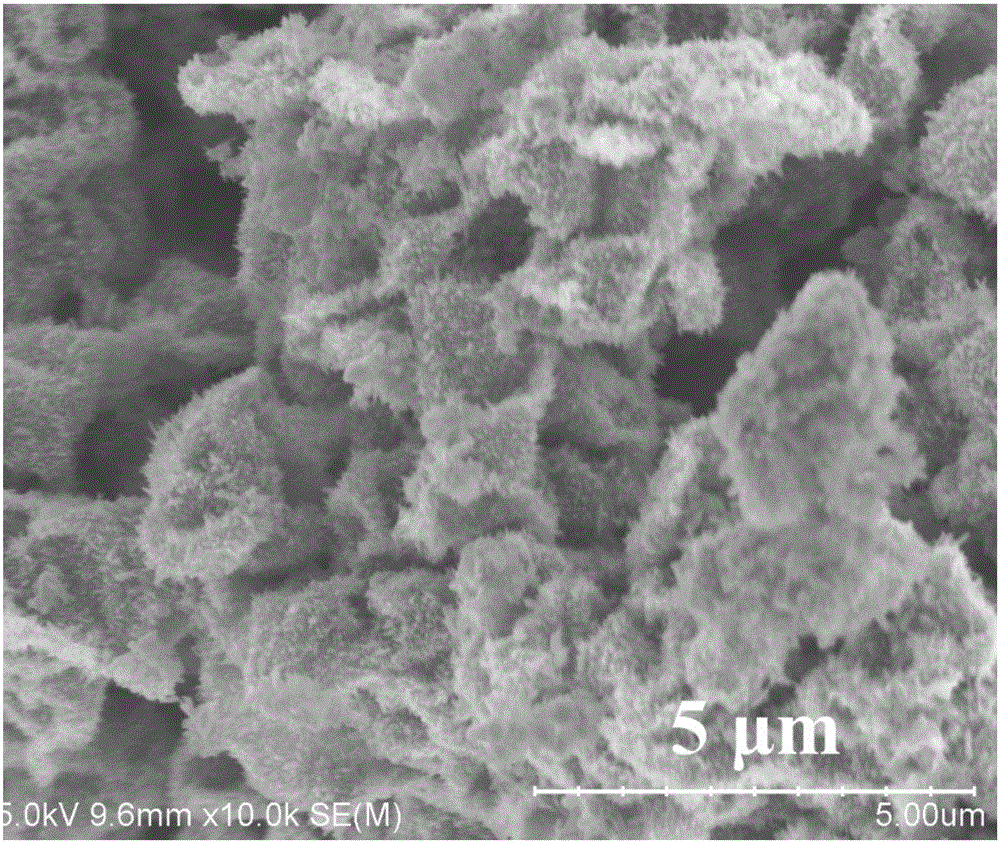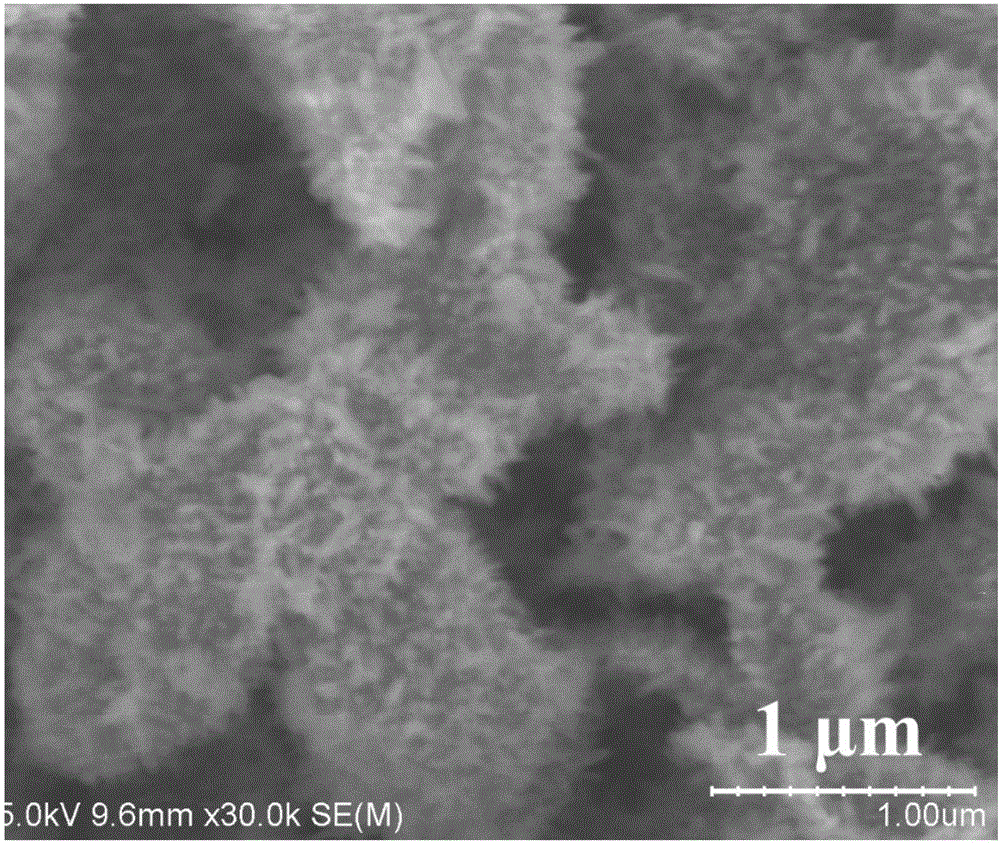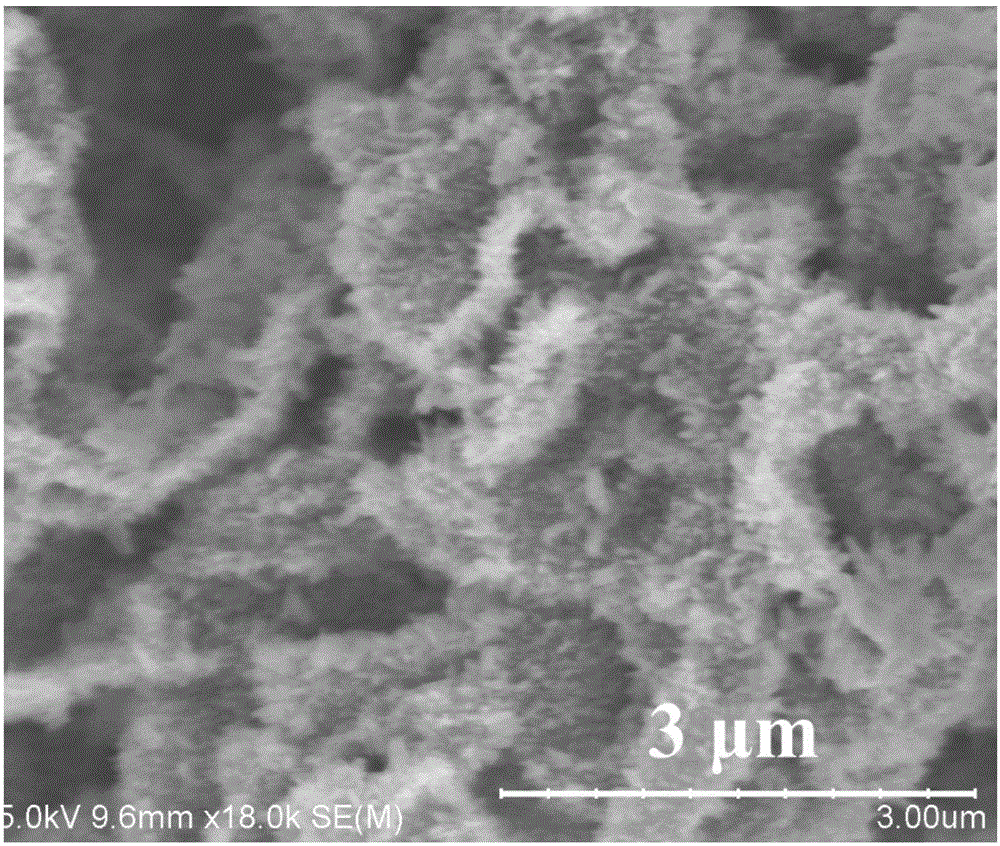Preparation method of iron trioxide/graphene composite material, negative electrode of lithium-ion battery and lithium-ion battery
A technology of ferric oxide and lithium-ion batteries, which is applied in the field of nanomaterials, can solve problems such as difficult large-scale synthesis, high energy consumption, and decreased conductivity of the negative electrode, and achieve low requirements for equipment, simple synthesis steps, and improved battery performance. Effect
- Summary
- Abstract
- Description
- Claims
- Application Information
AI Technical Summary
Problems solved by technology
Method used
Image
Examples
Embodiment 1
[0036] Preparation of graphite oxide: weigh 5.0g graphite and 3.75g NaNO respectively 3 Put it into a 1L beaker, stir vigorously, slowly add 150mL of concentrated sulfuric acid, stir for 0.5 hours, then slowly add 20g of KMnO 4 , Added in 0.5 hours, and continued to stir for 20 hours, the viscosity of the reactant increased, and the stirring was stopped to obtain a paste-like purple-red substance. After standing for 5 days, slowly add 500mL deionized water and 30mLH 2 o 2 At this time, the color of the solution becomes more obvious bright yellow. After the solution is fully reacted, it is centrifuged and washed to obtain graphite oxide.
[0037] Hydrothermal process: Dissolve 70mg graphite oxide in 80mL deionized water, add 6mL concentrated sulfuric acid (ρ=1.84g / cm 3 ), ultrasonically dispersed for 3 hours, the solution was moved into a small glass bottle, and then it was transferred to five hydrothermal reactors on average, reacted in a 200 ° C oven for 30 hours, washed, ...
Embodiment 2
[0041] The preparation method of graphite oxide is with embodiment 1.
[0042] Hydrothermal process: Dissolve 100mg of graphite oxide in 80mL of deionized water, add 8mL of concentrated sulfuric acid, ultrasonically disperse for 3 hours, transfer the solution into a small glass bottle, and then transfer it to 5 hydrothermal reaction kettles on average, React in an oven at 180°C for 20 hours, wash, and collect to obtain 20 mg of three-dimensional columnar reduced graphene oxide.
[0043] Composite process: Dissolve 1.8g of ferric chloride in 14mL of deionized water, add 4.0g of urea, add 20mg of three-dimensional columnar reduced graphene oxide to the above solution, soak in a water bath at 10°C for 3 days, then mix the solution with the three-dimensional The columnar reduced graphene oxide was transferred to a reaction kettle, reacted in an oven at 210°C for 34 hours, washed the product, dried in vacuum at 60°C for 4 hours, and collected the product.
[0044] Roasting process...
Embodiment 3
[0046] The preparation method of graphite oxide is with embodiment 1.
[0047] Hydrothermal process: Dissolve 120mg of graphite oxide in 80mL of deionized water, add 10mL of concentrated sulfuric acid, ultrasonically disperse for 3 hours, transfer the solution into a small glass bottle, and then transfer it to 5 hydrothermal reaction kettles on average. React in an oven for 18 hours, wash, and collect to obtain 24 mg of three-dimensional columnar reduced graphene oxide.
[0048] Composite process: Dissolve 2.0g ferrous sulfate in 14mL deionized water, add 2.5g urea, add 24mg three-dimensional columnar reduced graphene oxide to the above solution, soak in a water bath at 50°C for 3 days, then mix the solution and three-dimensional columnar The reduced graphene oxide was transferred to a reaction kettle, reacted in an oven at 210°C for 36 hours, washed the product, dried in vacuum at 60°C for 4 hours, and collected the product.
[0049] Roasting process: take the product and ro...
PUM
 Login to View More
Login to View More Abstract
Description
Claims
Application Information
 Login to View More
Login to View More - R&D
- Intellectual Property
- Life Sciences
- Materials
- Tech Scout
- Unparalleled Data Quality
- Higher Quality Content
- 60% Fewer Hallucinations
Browse by: Latest US Patents, China's latest patents, Technical Efficacy Thesaurus, Application Domain, Technology Topic, Popular Technical Reports.
© 2025 PatSnap. All rights reserved.Legal|Privacy policy|Modern Slavery Act Transparency Statement|Sitemap|About US| Contact US: help@patsnap.com



